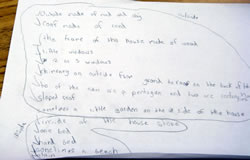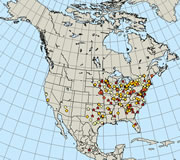Learning Laboratory Library
This page contains examples of items that might be in your learning laboratory library.
Electronic Keyboards
 For projects that involve writing but don't require a laptop, electronic keyboards such as the Alphasmart are a great choice.
For projects that involve writing but don't require a laptop, electronic keyboards such as the Alphasmart are a great choice.
The following example demonstrates how electronic keyboards facilitate the learning experiences of the student information scientist.
Information Intern
Haley wants to be a greeting card writer and is always on the lookout for poems, quotes, and pictures. Alphasmart electronic keyboards are available in the learning laboratory for writing activities. Haley writes the captions for the cards in fun fonts, then uses the infrared feature to beam her project to the color printer. She uses the "silly shaped scissors" in the Communication Castle to cut out the text. Then, creates her cards.
Explore Haley's investigation for more detail.
Realia and Models
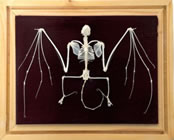 Real objects play an important role in the investigations of student information scientists. This "realia" may include tools, uniforms, inventions, coins, and other artifacts. Rocks, shells, bones, fur, skin, feathers and other natural objects are exciting, thought-provoking materials for learners of all ages. Some learning laboratories even support living collections including insects, plants, and animals.
Real objects play an important role in the investigations of student information scientists. This "realia" may include tools, uniforms, inventions, coins, and other artifacts. Rocks, shells, bones, fur, skin, feathers and other natural objects are exciting, thought-provoking materials for learners of all ages. Some learning laboratories even support living collections including insects, plants, and animals.
These real objects provide opportunities for students to generate questions, make observations, and test ideas.
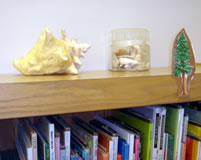 Students may also use models and other representations to help them understand topics from the human body to the solar system.
Students may also use models and other representations to help them understand topics from the human body to the solar system.
The learning laboratory provides access to these materials. When it's not possible to house these objects, the school library media specialist reaches out to classroom teachers and community members. They may also digital materials and have visual and auditory representations available.
The following examples demonstrates how realia and models facilitate the learning experiences of the student information scientist.
The Snake Wranglers
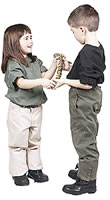 The local humane society contacted the school about a collaboration related to animal care. Having already worked on a nature center in the courtyard adjoining the library, Ms. Anderson was ready to bring nature into the center. A group of children called the Critter Wranglers care for the snake and manage the nature area.
The local humane society contacted the school about a collaboration related to animal care. Having already worked on a nature center in the courtyard adjoining the library, Ms. Anderson was ready to bring nature into the center. A group of children called the Critter Wranglers care for the snake and manage the nature area.
Explore Taylor's investigation for more detail.
Explore Ms. Anderson's involvement as an instructional specialist.
The Rockhounds
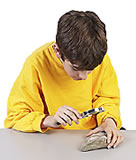 The local rockhounding club has donated rock and mineral specimens to the school. As part of an earth science project, the fifth grade class is classifying and cataloging these rocks.
The local rockhounding club has donated rock and mineral specimens to the school. As part of an earth science project, the fifth grade class is classifying and cataloging these rocks.
Explore Nathan's investigation for more detail.
Explore Mr. Samuel's and Mr. Campbell's involvement as an instructional specialist.
Looking Closer
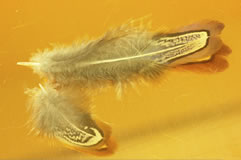 Isabella enjoys looking at the world through a magnifying glass or microscope. She's particularly interested in collecting and viewing bird feathers. She spends lots of time in the nature area of the learning laboratory and was excited to see a huge bulletin board being set up by a group of children for a project called The Great Backyard Bird Count.
Isabella enjoys looking at the world through a magnifying glass or microscope. She's particularly interested in collecting and viewing bird feathers. She spends lots of time in the nature area of the learning laboratory and was excited to see a huge bulletin board being set up by a group of children for a project called The Great Backyard Bird Count.
Isabella expresses an interest to the school library media specialist. Ms. Anderson suggests that she might be a "project coordinator" helping Miss Hamilton and assisting the younger learners. She's thrilled with the idea of sharing her feather collection and helping with the bird count project. As part of the bird project she creates an exhibit of her best feathers to share.
Explore Isabella's investigation for more detail.
Explore Ms. Anderson's and Miss Hamilton's involvement as an instructional specialist.
Calculators
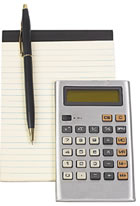 Although calculators have been popular for nearly thirty years, they continue to be an important tool in projects involving calculation.
Although calculators have been popular for nearly thirty years, they continue to be an important tool in projects involving calculation.
The following examples demonstrates how calculators facilitate the learning experiences of the student information scientist.
Just Like New!
Working a project for English and Math, Lizzie is planning a home improvement project. Her family is going to put vinyl siding on their house. With the help of her friend, she takes measurements of the house and uses the calculator to determine the amount of materials needed for the project. Ultimately she uses an electronic spreadsheet to create her project budget.
Explore Lizzie's investigation for more detail.
Video Cameras
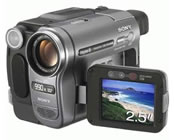 Today's digital video cameras area light weight and easy to use.
Today's digital video cameras area light weight and easy to use.
The following example demonstrates how video cameras facilitate the learning experiences of the student information scientist.
Civil Rights Movement
Isaac has heard that his grandfather was active in the Civil Rights Movement in the 1960s. He wants to videotape his grandfather's experiences for an oral history project.
Working with Ms. Anderson in the library media center, Issac develops his questions and learns to use the video equipment. His grandfather is thrilled with the results and agrees to have his video shared at open house.
Explore Isaac's investigation for more detail.
Floor Coverings
From world and road maps to alphabets and numbers, floor coverings can be use to stimulate interest and inquiry. While some may be permanent additions to the library or classroom, others may be used with thematic activities.
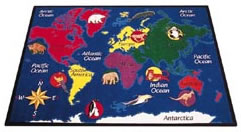
Seating Areas
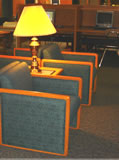 A variety of seating areas is important in a learning laboratory. The learning space must be flexible enough to accommodate large group activities and class meetings. However, sometimes students need a quiet, comfortable place to read. At other times, clusters of chairs are needed for small group discussion.
A variety of seating areas is important in a learning laboratory. The learning space must be flexible enough to accommodate large group activities and class meetings. However, sometimes students need a quiet, comfortable place to read. At other times, clusters of chairs are needed for small group discussion.
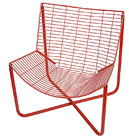 Lighting is also an important consideration in seating areas. Many learning laboratories have lamps and reading lights in addition to the standard lighting often found in a library.
Lighting is also an important consideration in seating areas. Many learning laboratories have lamps and reading lights in addition to the standard lighting often found in a library.
From bathtubs to car seats, learning laboratories find creative ways to provide comfortable seating for reading, thinking, and reflection.
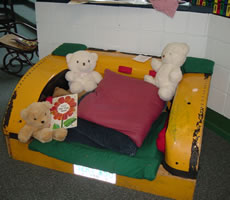
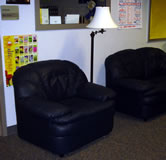 The following examples demonstrates how seating areas facilitate the learning experiences of the student information scientist.
The following examples demonstrates how seating areas facilitate the learning experiences of the student information scientist.
Public Health for All
It's difficult for Jamal to find a good place to read at home. He's found that the comfortable leather chairs in the library are the perfect place catch up. He's been reading The Great Influenza: The Epic Story of the 1918 Pandemic by John M. Barry.
Explore Jamal's investigation for more detail.
Work Boards
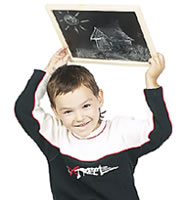 Sometimes student information scientists needs tools for brainstorming, writing, and drawing. Mini whiteboards and chalkboards work great for these types of activities. Magnetic boards area also useful for sorting and organizing ideas.
Sometimes student information scientists needs tools for brainstorming, writing, and drawing. Mini whiteboards and chalkboards work great for these types of activities. Magnetic boards area also useful for sorting and organizing ideas.
The following example demonstrates how writing boards facilitate the learning experiences of the student information scientist.
Listen, Draw, Read!
Michael enjoys drawing, but is having difficult with reading. He is easily frustrated and often throws tantrums when things don't go his way. His teacher has found that books on tape and CD seem soothing to him. He seems more focused when he can listen and draw what he hears or read along with the book.
Explore Michael's investigation for more detail.
Clipboard
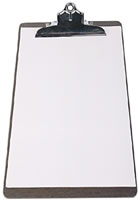 Clipboards, notepads, and other writing tools are helpful in planning and communication.
Clipboards, notepads, and other writing tools are helpful in planning and communication.
The following example demonstrates how clipboards facilitate the learning experiences of the student information scientist.
Information Investigator
When her teacher asked for volunteers to create a skit for younger students about maintaining a healthy body, Maya volunteered. They used clipboards for both planning and as part of their skit.
Explore Maya's investigation for more detail.
Pens, Markers, and Pencils
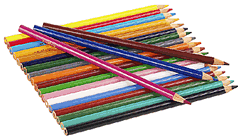 Student information scientists use a variety of writing tools including pens, markers, and pencils to do their work.
Student information scientists use a variety of writing tools including pens, markers, and pencils to do their work.
The following example demonstrates how writing tools facilitate the learning experiences of the student information scientist.
Architecture in Our Community
Katie is looking forward to the school-wide art fair. Regional artists will be displaying their work in the school library media center. These regional artists will also serve as judges for the annual art competition.
Katie enjoys using crayons and markers for her art projects
Explore Katie's investigation for more detail.
Electronic Databases
 An electronic database is a collection of information organized so that a computer can quickly access requested data. Like a traditional file cabinet, databases are organized by fields, records, and files. A wide range of tools allow users to browse or search the contents of electronic databases.
An electronic database is a collection of information organized so that a computer can quickly access requested data. Like a traditional file cabinet, databases are organized by fields, records, and files. A wide range of tools allow users to browse or search the contents of electronic databases.
To learn more about electronic databases, go to the external resource: Electronic Database for Children and Young Adults.
 The following examples demonstrates how electronic databases facilitate the learning experiences of the student information scientist.
The following examples demonstrates how electronic databases facilitate the learning experiences of the student information scientist.
National Forest Debate
Through Inspire and the state of Indiana, the learning laboratory has access to Gale's Opposing Viewpoints Resource Center database (click the example screen below to enlarge). This resource provides articles on different perspectives related to current issues. For example, Cody is interested in different views on logging and the lumber industry in national forests.
Explore Cody's investigation for more detail.
Digital Cameras
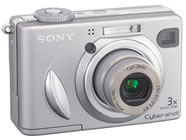 The digital camera has become an essential tool in today's learning laboratory. Used to record science experiments, archive events, and create photo essays, the uses are endless.
The digital camera has become an essential tool in today's learning laboratory. Used to record science experiments, archive events, and create photo essays, the uses are endless.
The following example demonstrates how digital cameras facilitate the learning experiences of the student information scientist.
Information Intern
Alano enjoys recording the world around him with a digital camera. He has an eye for visual work. He's also very interested in the role of photography in the media.
Explore Alano's investigation for more detail.
Display Areas
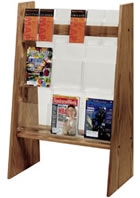 The learning laboratory contains many different types of display areas.
The learning laboratory contains many different types of display areas.
Some displays such as book, magazine, and media cases are used to provide access to information resources.
 Other displays areas such as learning stations are designed to be used by students for hands-on activities. Students might manipulate the bones in a skeleton, examine travel brochures, or create a pop-up book.
Other displays areas such as learning stations are designed to be used by students for hands-on activities. Students might manipulate the bones in a skeleton, examine travel brochures, or create a pop-up book.
In an effective learning laboratory, students are involved in creating displays and sharing the results of their inquiries.
The following examples demonstrates how display areas facilitate the learning experiences of the student information scientist.
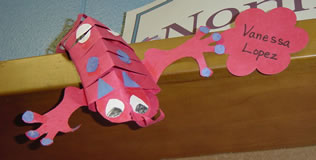
Queen of Cards
One of Haley's favorite places to visit is the Communicator's Castle in the school library media center. She's known as the "Queen of Cards". Alphasmart electronic keyboards are available in the learning laboratory for writing activities. She writes the captions for the cards in fun fonts, then uses the infrared feature to beam her project to the color printer. She uses the "silly shaped scissors" in the Communication Castle to cut out the text. Then, creates her cards. Student projects are shared on the Castle walls.
Explore Haley's investigation for more detail.
Exhibits
 History fair, science fair, and media contests are just a few of the activities and events where the student information scientist shares products in the learning laboratory. For example, the illustrations below are part of a history exhibit on Colonial Jamestown.
History fair, science fair, and media contests are just a few of the activities and events where the student information scientist shares products in the learning laboratory. For example, the illustrations below are part of a history exhibit on Colonial Jamestown.
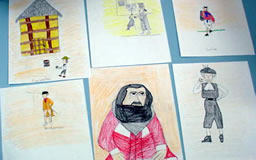
The following examples demonstrates how exhibits facilitate the learning experiences of the student information scientist.
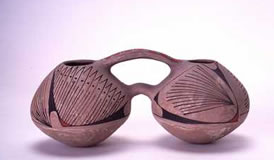 American Indian Heritage
American Indian Heritage
The museum project got Megan interested in learning more about her American Indian heritage. Using artifacts contributed from her grandmother, Megan developed a history fair project to submit to the state contest. Her project along with three others were selected for display in the library media center for History Month.
Explore Megan's investigation for more detail.
 Looking Closer
Looking Closer
Isabella expresses an interest in the The Great Backyard Bird Count project to the school library media specialist. Ms. Anderson suggests that she might be a "project coordinator" helping Miss Hamilton and assisting the younger learners. She's thrilled with the idea of sharing her feather collection. As part of the bird project she creates an exhibit of her best feathers to share. She also creates a photo tutorial on the proper way to care and preserve for feathers.
Explore Isabella's investigation for more detail.
Explore Ms. Anderson's and Miss Hamilton's involvement as an instructional specialist.
Portfolio and Electronic Portfolio
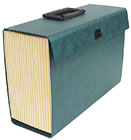 Portfolios and electronic portfolio are an important tool of the student information scientist. Students use portfolios as a way to organize and review their learning.
Portfolios and electronic portfolio are an important tool of the student information scientist. Students use portfolios as a way to organize and review their learning.
Portfolios include both process materials as well as final products. For example, the item below (click to enlarge the visual) shows a planning sheet for a project on Colonial Jamestown.
The following examples demonstrates how portfolios facilitate the learning experiences of the student information scientist.
National Forest Debate
Cody was very proud of his success on his national forest project. He decides to add this final report to his portfolio along with other documents that he's been collecting throughout his high school career.
Explore Cody's investigation for more detail.
Maps and Globes
 Maps and globes allow the student information scientist to study the world from a distance. Whether planning a trip, analyzing the patterns of earthquakes, or examining the cultures of countries, maps and globes provide a concrete reference tool.
Maps and globes allow the student information scientist to study the world from a distance. Whether planning a trip, analyzing the patterns of earthquakes, or examining the cultures of countries, maps and globes provide a concrete reference tool.
Historical maps are used to analyze the development of urban areas over time, while topographical maps can be used to understand why some areas might be more or less populated based on the terrain.
The following examples demonstrates how maps and globes facilitate the learning experiences of the student information scientist.
Global Trotter
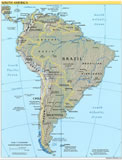 After reading the book The Motorcycle Diaries: A Latin American Journey by Ernesto Che Guevara and then watching the movie, Dylan dreams of retracing the journey through South America. Dylan explored a variety of maps before selecting one to use in his exploration of South America.
After reading the book The Motorcycle Diaries: A Latin American Journey by Ernesto Che Guevara and then watching the movie, Dylan dreams of retracing the journey through South America. Dylan explored a variety of maps before selecting one to use in his exploration of South America.
Explore Dylan's investigation for more detail.
Explore Mr. Washington's involvement as an instructional specialist
Explore other examples of map and globe use:
Explore Kristen's investigation for more detail.
Explore Nathan's investigation for more detail.
Butterfly Migration
Each year the group participates in the Journey North project. This global study involves students in sharing their field observations with others across North America. They view the progress of the project on the Journey North Monarch Butterfly website and trace the migration on a wall map in the learning laboratory where others can share the experience. The visual below shows a map from the website. Click the map to learn more about this project.
Explore Samantha's investigation for more detail.
Handheld and Mobile Devices
 From cellphones and smartphones to PDAs and GPS devices, a wide range of handheld tools are available for the student information scientist.
From cellphones and smartphones to PDAs and GPS devices, a wide range of handheld tools are available for the student information scientist.
School libraries are increasingly becoming involved with ebook readers such as the Kindle and the Nook.
The introduction of the iPad has brought a new dimension to mobile technology. Less power than a laptop or more features than an ebook, the iPad is being watched closely as an all-purpose tool for schools.
To learn more about handheld devices, go to the external resource: Handheld Devices in the Classroom.
The following example demonstrates how handheld devices facilitate the learning experiences of the student information scientist.
The Rockhounds
 As part of a geology grant, GPS devices and GIS software is available in the library media center. Working in small groups, students are identifying donated rocks and using GPS/GIS tools to identify locations in the local area where these interesting specimens can be found.
As part of a geology grant, GPS devices and GIS software is available in the library media center. Working in small groups, students are identifying donated rocks and using GPS/GIS tools to identify locations in the local area where these interesting specimens can be found.
Nathan is interested in geocaching and suggests to Mr. Campbell that the GPS locations might be used as part of a virtual geocache project.
Explore Nathan's investigation for more detail.
Explore Mr. Samuels's and Mr. Campbell's involvement as an instructional specialist.
Audio Tools
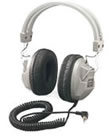 Headphones, microphones, and audio player/recorders are just a few of the tools available for auditory learners.
Headphones, microphones, and audio player/recorders are just a few of the tools available for auditory learners.
Students can record their voices into the computer, an MP3 recorder, or tape player. This tool can be used to record notes, reading samples, or to create their own books-on-tape. Students can conduct audio interviews, built audio into their classroom museum exhibits, or create audio tutorials.
The following examples demonstrates how audio tools facilitate the learning experiences of the student information scientist.
Listen, Draw, Read!
Michael learns most effectively by listening. He listens to audio books on CD while reading along with books.
Michael is interested in all kinds of transportation, particularly construction equipment like bulldozers and dump trucks. He's been investigating how each construction vehicle is used. Working with his special needs teacher and the media specialist, Michael is using the KidPix software to draw pictures, write descriptions, and record his narration.
Explore Michael's investigation for more detail.
MP3 Players
MP3 players are a great tool for listening to music, but also a wonderful way to listen to audiobooks and podcasts.
The following examples demonstrates how MP3 players facilitate the learning experiences of the student information scientist.
Global Trotter
 Dylan knows that he'll have to be fluent in Spanish before visiting South America. He's not worried about reading and writing the language. Instead, he's concerned about being able to understand when people talk to him. He discusses this frustration with his teacher who suggests that they investigate Spanish speaking sources on the Internet.
Dylan knows that he'll have to be fluent in Spanish before visiting South America. He's not worried about reading and writing the language. Instead, he's concerned about being able to understand when people talk to him. He discusses this frustration with his teacher who suggests that they investigate Spanish speaking sources on the Internet.
Dylan locates a daily Spanish language podcast that can be downloaded using iTunes. Unfortunately he doesn't have an MP3 player, so he has to listen to the podcast in the school library media center.
As Mr. Washington reviews his use statistics, he finds that an increasing number of students are downloading podcasts, digital books, and other audio materials. These students account for many hours on the computers when they actually only need an MP3 player. He decides to invest in 6 small ipods that can be checked out by students for 3 day periods to reduce the strain on his computers.
Dylan is thrilled with the ipods. He can download a week of podcasts on an ipod and listen to them over the weekend.
Explore Dylan's investigation for more detail.
Journals
 Journaling is an important activity of the student information scientist. The learning laboratory provides a great environment for working on journaling activities. Whether brainstorming, organizing ideas, taking notes, or reflecting on the process, the laboratory support the information needs of students.
Journaling is an important activity of the student information scientist. The learning laboratory provides a great environment for working on journaling activities. Whether brainstorming, organizing ideas, taking notes, or reflecting on the process, the laboratory support the information needs of students.
The following examples demonstrates how journals facilitate the learning experiences of the student information scientist.
Glorious Gardens
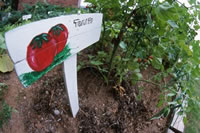 Journaling is an important activity for gardeners. Ashley has been keeping a garden journal for three years. In addition to tracking her plantings, she also keep notes about things she learns in science, suggestions from fellow gardeners, and ideas for future projects. She's considering whether to start keeping a digital journal so she can incorporate digital photos of her garden.
Journaling is an important activity for gardeners. Ashley has been keeping a garden journal for three years. In addition to tracking her plantings, she also keep notes about things she learns in science, suggestions from fellow gardeners, and ideas for future projects. She's considering whether to start keeping a digital journal so she can incorporate digital photos of her garden.
Explore Ashley's investigation for more detail.
Laptops and Tablets
 The laptop computer is an essential learning laboratory tool. Unlike a desktop computer, laptops can be used throughout the learning environment on floors, tables, desks, and even outdoors! Increasingly, tablets such as ipads are replacing some laptops.
The laptop computer is an essential learning laboratory tool. Unlike a desktop computer, laptops can be used throughout the learning environment on floors, tables, desks, and even outdoors! Increasingly, tablets such as ipads are replacing some laptops.
The following examples demonstrates how laptops facilitate the learning experiences of the student information scientist.
Laptops in the Learning Laboratory
Explore Alyssa's investigation for more detail.
Explore Hannah's investigation for more detail.
Explore Brandon's investigation for more detail.
Explore Eric's investigation for more detail.
Measuring Tools
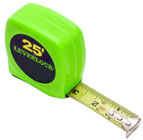 Rulers, probes, measuring tapes, and other tools are essential in a well-stocked learning laboratory.
Rulers, probes, measuring tapes, and other tools are essential in a well-stocked learning laboratory.
The following example demonstrates how measuring tools facilitate the learning experiences of the student information scientist.
Just Like New!
Working a project for English and Math, Lizzie is planning a home improvement project. Her family is going to put vinyl siding on their house. With the help of her friend, she takes measurements of the house and uses the calculator to determine the amount of materials needed for the project. Ultimately she uses an electronic spreadsheet to create her project budget.
Explore Lizzie's investigation for more detail.
Inviting Environment
 The learning laboratory is an inviting and exciting place to work. With interesting wall coverings, well-maintained furnishings and contemporary themes, this attractive environment is welcoming to all learners.
The learning laboratory is an inviting and exciting place to work. With interesting wall coverings, well-maintained furnishings and contemporary themes, this attractive environment is welcoming to all learners.
Consider opening an IMC Cafe (examples).
Students are active participants in creating this stimulating atmosphere. The walls, displays, bookcases, and even ceilings are filled with student-created products.
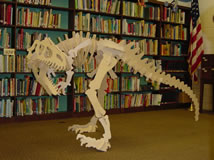
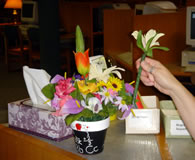

Learners work collaboratively on projects that enrich the entire student population as well as the local community.
The following example demonstrates how an inviting environment facilitates the learning experiences of the student information scientist.
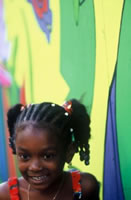 Murals
Murals
Vanessa has been studying what she likes best about the murals she's seen such as the use of color, lines, shadows, and subjects. She has joined a group of children who are creating ceiling tiles representing their favorite book characters. The media specialist suggests that she share what she's learned about murals with the group as part of their ceiling tile project.
They looked at some examples of ceiling tiles from a school in Huntsville, Alabama for ideas:
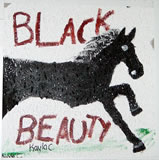
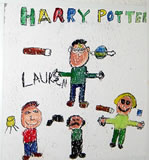
Explore Vanessa's investigation for more detail.
Telephones, Cell Phones, and Smart Phones
 Telephones are a way to reach outside the learning laboratory.
Telephones are a way to reach outside the learning laboratory.
The following example demonstrates how telephones facilitate the learning experiences of the student information scientist.
Community Bike Path
Mr. Washington, the teacher librarian suggests that Eric contact local city council members about his idea for a "Rails to Trails" community bike path project. After reviewing Eric's questions and providing suggestions, Mr. Washington helps Eric locate the phone numbers of council members and suggests a quiet place where he can make some calls. Although most of the council members has other priorities, he found one enthusiastic supporter. Eric arranged to meet the council member and design a plan.
Explore Eric's investigation for more detail.
Charts and Post-Its postits
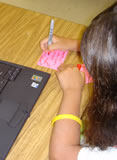 Chart paper, flip charts, and Post-It notes are just a few of the tools student information scientists can use to organize information and visualize ideas.
Chart paper, flip charts, and Post-It notes are just a few of the tools student information scientists can use to organize information and visualize ideas.
The following example demonstrates how charts and post-its facilitate the learning experiences of the student information scientist.
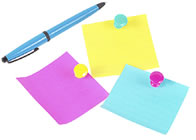 Java's Not Just Coffee
Java's Not Just Coffee
Hannah is interested in learning more about the impact of the Tsumani in Indonesia. She chooses the country of Java.
As she collects information about the country, she uses Post-it notes to classify facts and ideas.
Explore Hannah's investigation for more detail.
Student Work
The learning laboratory is place where students not only use information resources, but also design, create, and share their own products.
Student work is displayed throughout the laboratory on walls, in display cases, on bookcases, and even hanging from the ceiling.
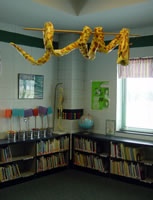
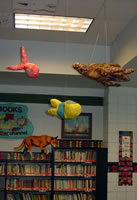
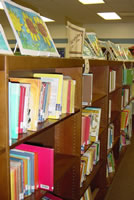
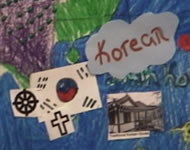
Get students involved in large scale projects across the curriculum. For example the Culture Study map contains information from science on biomes and social studies on countries.
The following examples demonstrate how student work impacts the learning experiences of the student information scientist.
Architecture in Our Community
showing workKatie is excited about the school-wide art fair. Student artwork is displayed in the school library media center and regional artists act as judges. This year students are submitting their designs for the county courthouse.
Explore Katie's investigation for more detail.
Student Work Areas
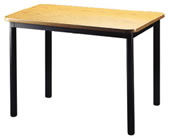 Student information scientists need work areas that meet their information inquiry needs. Areas are needed to spread out resources, organize materials, and products. Some activities require electrical outlets near tables, while other assignments need large open spaces on the floor.
Student information scientists need work areas that meet their information inquiry needs. Areas are needed to spread out resources, organize materials, and products. Some activities require electrical outlets near tables, while other assignments need large open spaces on the floor.
Instructional specialists carefully design student work areas to accommodate these varied needs and activities.
 The following examples demonstrate how student work areas facilitate the learning experiences of the student information scientist.
The following examples demonstrate how student work areas facilitate the learning experiences of the student information scientist.
Solar Solutions
Sabrina is working with a small group on a project for her Environmental Studies class. Her group needs access to Internet, so they gather in the wireless laptop cluster area of the media center. These tables have lots of room to spread out and they also have electrical outlets in case they need to plug in computers. While a couple members of the group are working on charts, signs, and other materials for their presentation, others are using the laptops to finish up their research.
Explore Sabrina's investigation for more detail.
Science and Math Tools
![]() From thermometers to math rods, science and math tools can be found throughout the learning laboratory. The key is providing access at the teachable moment.
From thermometers to math rods, science and math tools can be found throughout the learning laboratory. The key is providing access at the teachable moment.
Many tools can be attached to computers or handheld devices. For example, digital cameras, scanners, microscopes, and probes can all help students examine objects, conduct experiments, and record results.
The following example demonstrates how science and math tools facilitate the learning experiences of the student information scientist.
The Science of Bubbles
Jasmine has always been fascinated with bubbles. After her teacher introduced the interesting connections between air and water, Jasmine decided to investigate the science of bubbles. She found the tools she needs in the mini-lab set up through a partnership between the primary teachers and the media specialist.
Explore Jasmine's investigation for more detail.
videoproductionVideo Production Area
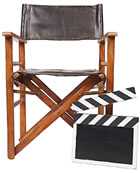 The student information scientist can use video in many different ways. Plays, skits, interviews, music videos, documentaries, presentations... the possibilities for video production are endless.
The student information scientist can use video in many different ways. Plays, skits, interviews, music videos, documentaries, presentations... the possibilities for video production are endless.
Students need an area where they can access equipment, props, lighting, and other materials to facilitate video production.
The following examples demonstrate how video production area facilitate the learning experiences of the student information scientist.
Civil Rights Movement
Isaac wants to videotape his grandfather's experiences for an oral history project. Working with Ms. Anderson in the library media center, Issac develops his questions and learns to use the video equipment.
Explore Isaac's investigation for more detail.
Visual Presenter
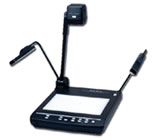 When joined with a data projector or television class, the visual presenter can be used to provide shared reading experiences, explore tiny objects close up, or examine primary source documents.
When joined with a data projector or television class, the visual presenter can be used to provide shared reading experiences, explore tiny objects close up, or examine primary source documents.
The following example demonstrates how visual presenter facilitate the learning experiences of the student information scientist.
Closer Look
Normally, Isabella isn't interested in social studies, but when her teacher explained that they would be using the magnifying glass she perked up. Their mission was to investigate the forms and functions of money. She was even more excited when her teacher brought the visual presenter into the classroom. They looked at quarters close-up and could see the tiny images etched on the coins.
Explore Isabella's investigation for more detail.
Electronic Whiteboard
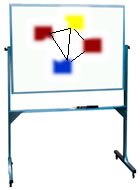 Interactive, electronic whiteboards are gaining in popularity in schools. SMART technology is one of the most popular interactive whiteboard options. These boards are attached to a laptop and data projector.
Interactive, electronic whiteboards are gaining in popularity in schools. SMART technology is one of the most popular interactive whiteboard options. These boards are attached to a laptop and data projector.
To learn more about electronic whiteboards, go to the external resource: Engaging Learners the SMARTboard Way.
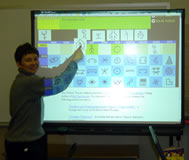
The following examples demonstrates how electronic whiteboards facilitate the learning experiences of the student information scientist.
Student Information Scientist
An active boy, Ryan works best when standing. He's developed a love of the electronic whiteboard in the learning laboratory. He enjoyed using interactive websites such as Put Annie Back Together and Edheads activities.
Explore Ryan's investigation for more detail.
Books and Periodicals
 Although the learning laboratory is filled with a variety of materials, the book collection still plays a vital role for the student information scientist. Periodicals continue to be a source for timely information.
Although the learning laboratory is filled with a variety of materials, the book collection still plays a vital role for the student information scientist. Periodicals continue to be a source for timely information.
The following examples demonstrate how books facilitate the learning experiences of the student information scientist.
Public Health for Fall
After reading The Great Influenza: The Epic Story of the 1918 Pandemic by John M. Barry, Jamal became hooked on non-fiction reading. The mix of medical history, science, and social issues brought history alive and spurred questions about today's public health system.
Explore Jamal's investigation for more detail.
Explore Mr. Washington's involvement as an instructional specialist.
Lewis, Clark, and Kristen: Explorers
After watching a video on Lewis and Clark, Kristen became interested in learning more about their expedition. The media specialist directed her to a well-respected book in this area for more detailed information, Undaunted Courage.
Explore Kristen's investigation for more detail.
Explore Mr. Samuels's involvement as an instructional specialist.
Global Trotter
After reading the book The Motorcycle Diaries: A Latin American Journey by Ernesto Che Guevara, Dylan dreams of retracing the journey through South America.
Explore Dylan's investigation for more detail.
Explore Mr. Washington's involvement as an instructional specialist.
Puppets
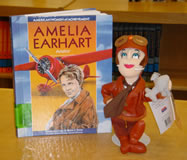 The learning laboratory has many resources for hands-on exploration including puppets. Materials area also available in the Communication Castle to create puppets, scenery, and other items needed to produce skits and shows.
The learning laboratory has many resources for hands-on exploration including puppets. Materials area also available in the Communication Castle to create puppets, scenery, and other items needed to produce skits and shows.
Puppets and stuffed animals can be found throughout the learning laboratory to stimulate interest into reading and inquiry.
The following examples demonstrates how puppets facilitate the learning experiences of the student information scientist.
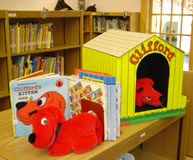
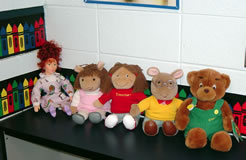
Fish Are Friends!
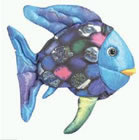 Alyssa and her best friend Emily are planning a puppet show focusing on the questions they have about fish. The fish puppet from The Rainbow Fish will be the star, but they area also creating their own puppets. They are decorating the puppet area of the media center to look like a coral reef.
Alyssa and her best friend Emily are planning a puppet show focusing on the questions they have about fish. The fish puppet from The Rainbow Fish will be the star, but they area also creating their own puppets. They are decorating the puppet area of the media center to look like a coral reef.
Explore Alyssa's investigation for more detail.
Explore Ms. Anderson's involvement as an instructional specialist.
Digital Media: CDs and DVDs
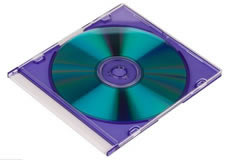 Digital media including CDs and DVDs contain text, audio, video, and animation.
Digital media including CDs and DVDs contain text, audio, video, and animation.
From audio books on CD to documentaries on DVD, digital media is a popular resource for student information scientists.
The following examples demonstrates how digital media facilitate the learning experiences of the student information scientist.
Lewis, Clark, and Kristen: Explorers
Many young people prefer video for gathering background information and stimulating questions for inquiry. A growing number of quality documentary resources are available on DVD. Since these videos can easily be viewed on a variety of players including laptops and personal players, they are a practical information resource.
Explore Kristen's investigation for more detail.
Explore Mr. Samuels's involvement as an instructional specialist.
Listen, Draw, Read!
Some young readers are more successful if they have the support of audio books. For example, Michael is becoming a more fluent reader through listening to books and drawing what he hears. The more he listens, the more interest he has in reading text. The learning laboratory has a variety of audio books on cassette and CD.
While some selections are specifically geared to students with reading problems, the collection is popular with all reading interests and levels.
Explore Michael's investigation for more detail.
Explore Ms. Anderson's involvement as an instructional specialist.
Global Trotter
After reading the book The Motorcycle Diaries: A Latin American Journey by Ernesto Che Guevara and then watching the movie, Dylan dreams of retracing the journey through South America.
Explore Dylan's investigation for more detail.
Explore Mr. Washington's involvement as an instructional specialist.
Young Authors
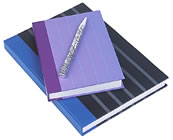 Students in the learning laboratory are contributers as well as consumers of information. Many young authors are excited about having their websites, books, and other materials housed in the library collection for others to enjoy.
Students in the learning laboratory are contributers as well as consumers of information. Many young authors are excited about having their websites, books, and other materials housed in the library collection for others to enjoy.
The following examples demonstrates how young authors facilitate the learning experiences of the student information scientist.
The Information Intern
Although Alano doesn't think of himself as a writer, his experience as an Information Intern has made him think about ways to combine his interest in combining the visual arts with writing. He's always been a fan of graphic novels. His creative writing teacher has agree to let him create a graphic novel as his final product.
His project turned out great and is now part of the young authors collection in the learning laboratory.
Explore Alano's investigation for more detail.
Presentation Areas
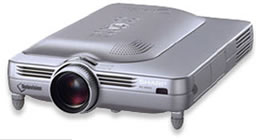 Data projectors, electronic whiteboards, microphones, speakers, backdrops, and screens are just a few of the resources students need to present their findings and share their ideas.
Data projectors, electronic whiteboards, microphones, speakers, backdrops, and screens are just a few of the resources students need to present their findings and share their ideas.
Lightweight portable equipment make it easy to turn open spaces into presentation areas.
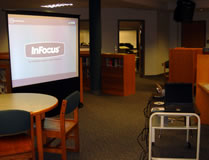 The following examples demonstrate how presentation areas facilitate the learning experiences of the student information scientist.
The following examples demonstrate how presentation areas facilitate the learning experiences of the student information scientist.
Java's Not Just Coffee
Hannah's class is studying countries of the world. She's chosen Java, an island that was impacted by the tsuamani. Hannah developed a PowerPoint presentation to share her findings. She's particularly excited about using the whiteboard to show how the tsumani changed the landscape of the country.
After watching the other students present their project, Hannah is a little nervous but still excited about her presentation.
Explore Hannah's investigation for more detail.
Blogs and Microblogs
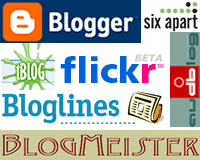 Blogs are web logs. Organized chronologically, these electronic journals provide a forum for the information scientist to record their experiences. They are also used as a source of information and commentary.
Blogs are web logs. Organized chronologically, these electronic journals provide a forum for the information scientist to record their experiences. They are also used as a source of information and commentary.
To learn more about blogs, microblogs, audio sharing, and rss feeds, go to Learning Spaces: Blogging, Podcasting, and Vlogging.
The following examples demonstrates how blogs facilitate the learning experiences of the student information scientist.
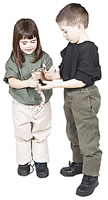 The Snake Wranglers
The Snake Wranglers
When the school library media specialist agreed to adopt the snake from the local humane society, she formed a group called the Critter Wranglers to observe and care for the snake.
The media specialist suggested that the Critter Wranglers record their experiences working with the snake. She suggested that they go to the Bird Treatment and Learning Center blog from Anchorage, Alaska for inspiration.
The students created their own blog called Jake the Snake.
Explore Taylor's investigation for more detail.
Explore Ms. Anderson's involvement as an instructional specialist.
E-mail and Text Messaging
 Whether sending messages, photographs, videos, or other files, email is a great communication tool. It allows students and teachers to reach out of their school or library and connect with others around the world.
Whether sending messages, photographs, videos, or other files, email is a great communication tool. It allows students and teachers to reach out of their school or library and connect with others around the world.
Email projects have been part of classrooms for more than a decade. One of the most popular projects involves tracking the migration of wildlife including the Monarch butterflies.
To learn more, go to the external resource from Teacher Tap: Email Tools and Technology-Rich Learning or Learning Spaces: Email & Text Messaging.
The following examples demonstrates how e-mail facilitate the learning experiences of the student information scientist.
Butterfly Migration
Each year the group participates in the Journey North project. This global study involves students in sharing their field observations with others across North America. The groups trace the migration of the Monarch Butterfly. Students keep charts of the migration patterns and report to the project through email. Click the map to learn more about this project.
Explore Samantha's investigation for more detail.
Electronic Discussion Forums and Social Networks
 Electronic discussion forums are a popular way for the student information scientist to interact with others and gather information.
Electronic discussion forums are a popular way for the student information scientist to interact with others and gather information.
Students hold classroom discussions every day. Why not hold virtual discussions with students from around the world? Discussions can be held from anywhere. With a wireless connection, students can even be outside. Discussion tools can be used to facilitate global understanding and sharing.
To learn more, go to the external resource from Teacher Tap: Discussion Tools and Technology-Rich Learning and Learning Spaces: Social Networks.
The following examples demonstrates how electronic discussion forums facilitate the learning experiences of the student information scientist.
The Rockhounds
Nathan is interested in geocaching. Geocaching is an exciting hobby developed with the advent of GPS (Global Positioning Satellite) handheld devices. Combining hiking and treasure hunting, geocaching involves hiking to a set of coordinates (longitude and latitude) to find a "cache." He suggests to Mr. Campbell that the GPS locations might be used as part of a virtual geocache project.
They wonder whether others have done this type of project, so they post a inquiry at the Geocaching Discussion Forum in the Education section. Nathan is excited to find that a number of geocachers post suggestions for their project.
Explore Nathan's investigation for more detail.
Live Virtual Interaction
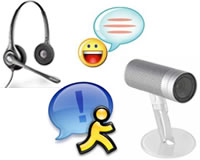 Live activities have their own opportunities and challenges. Chats involve typing messages to another person(s). These messages are logged on the screen in a long list as they are written. Other live interactions such as audio conferencing and video conferencing can use the same software. As a matter of fact, some people, chat, audio conference, video conference, and share files all at the same time!
Live activities have their own opportunities and challenges. Chats involve typing messages to another person(s). These messages are logged on the screen in a long list as they are written. Other live interactions such as audio conferencing and video conferencing can use the same software. As a matter of fact, some people, chat, audio conference, video conference, and share files all at the same time!
Chats and video conferences involve students in two-way or many way conversations. These interactions are synchronous. In other words, people are writing or talking in "real-time" as the event happens. Depending on the speed of the connection, there may be a slight delay, but this doesn't generally interfere with conversation.
To learn more, go to the external resource from Teacher Tap: Live Chats and Video Conferencing and Learning Spaces: Virtual Conferencing.
The following examples demonstrates how live virtual interaction facilitates the learning experiences of the student information scientist.
American Indian Heritage
Megan's grandmother knows many native dances. Unfortunately, her grandmother lives a thousand miles away. Mr. Samuels, the media specialist, suggests that the girls use video conferencing as a way to communicate.
With the use of web cams and a high-speed Internet connection, they're able to watch the dance and practice it themselves. Megan's grandmother can provide instant feedback and suggestions!
Explore Megan's investigation for more detail.
Website Resources
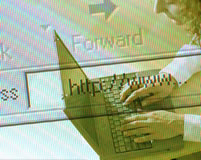 The World Wide Web is packed with information. However only a mature student information scientist will be successful locating quality information to support his or her investigation. A well-equipped learning laboratory provides a variety of tools for accessing the Internet including computer stations and wireless laptops.
The World Wide Web is packed with information. However only a mature student information scientist will be successful locating quality information to support his or her investigation. A well-equipped learning laboratory provides a variety of tools for accessing the Internet including computer stations and wireless laptops.
An effective learning laboratory also provides portals and "starting points" to support web exploration and searching.
Increasingly, young people are collaborating on the creation of their own web spaces.
To learn more, go to the external resource from Learning Spaces: Collaborative Web and Wikis.
The following examples demonstrates how website resources facilitate the learning experiences of the student information scientist.
 Glorious Gardens
Glorious Gardens
Ashley loves her garden. She entered her tomatoes in the 4H fair and won a second place red ribbon. However she's already seeking ways to improve next year's crop. As she analyzed her data, she found that the Burpee seeds were the best. She's going to use the Burpee website to explore other tomato plant options.
Explore Ashley's investigation for more detail.
Disaster Detector
 As Brandon watches the news about the latest natural disaster, he wonders whether it's possible to create better systems for detecting and planning for these events. As Brandon searches for information, he begins to notice that most of the websites direct users to the United States Geological Survey earthquake center website.
As Brandon watches the news about the latest natural disaster, he wonders whether it's possible to create better systems for detecting and planning for these events. As Brandon searches for information, he begins to notice that most of the websites direct users to the United States Geological Survey earthquake center website.
Explore Brandon's investigation for more detail.
Looking Closer
Miss Hamilton enjoys partnering with the school library media specialist, Ms. Anderson. Using a theme that acrosses grade and content areas, they've established a full-year project on birding. Using the web resource at The Great Backyard Bird Count as a starting place, they began exploring the many possible connections.
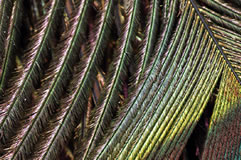 As the project gained attention within the school, an older student approached Miss Hamilton about becoming involved in the project. Isabella's interest in birds and bird feathers combined with Miss Hamilton's commitment to multi-age teaching was a great combination. Isabella become the project director and a mentor for younger children.
As the project gained attention within the school, an older student approached Miss Hamilton about becoming involved in the project. Isabella's interest in birds and bird feathers combined with Miss Hamilton's commitment to multi-age teaching was a great combination. Isabella become the project director and a mentor for younger children.
Explore Isabella's investigation for more detail.
Explore Ms. Anderson's and Miss Hamilton's involvement as an instructional specialist.
Wall Displays
 Effective learning laboratories use all the space available for teaching, learning, and inquiry. While some wall displays are produced by instructional specialists to share information or motivate students, others are created by students to share the results of their information inquiries. Some wall boards are collaborative areas where many students contribute their ideas.
Effective learning laboratories use all the space available for teaching, learning, and inquiry. While some wall displays are produced by instructional specialists to share information or motivate students, others are created by students to share the results of their information inquiries. Some wall boards are collaborative areas where many students contribute their ideas.
The following examples demonstrates how wall displays facilitate the learning experiences of the student information scientist.

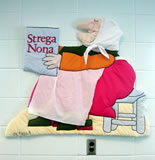
Butterfly Migration
Each year the group participates in the Journey North project. This global study involves students in sharing their field observations with others across North America. They view the progress of the project on the Journey North Monarch Butterfly website and trace the migration on a wall map in the learning laboratory where others can share the experience. The visual below shows a map from the website. Click the map to learn more about this project.
Explore Samantha's investigation for more detail.

